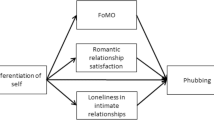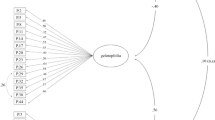Abstract
The present study examined the interpersonal relationship styles and the predictive power of family relationships on phubbing. Participants were 539 first year university students [383(71%) female, 156(29%) male, Mage = 18.84, SD = 1.18] who completed the questionnaires package the Phubbing Scale, Family Assessment Device, and Interpersonal Style Scale. Data analyzed through hierarchical regression. The results show that avoiding, angry, belittling, and manipulative interpersonal communication styles predict phubbing positively, while dominant style negatively predicts phubbing. In addition, it was determined that the general function of the family had a positive effect on predicting phubbing.
Similar content being viewed by others
Data Availability
The data sets used and/or analyzed during the current study is available from the corresponding author on scholarly request.
References
Aagaard, J. (2020). Digital akrasia: A qualitative study of phubbing. AI and Society, 35(1), 237–244. https://doi.org/10.1007/s00146-019-00876-0
Abbasi, I. S. (2019). Social media addiction in romantic relationships: Does user’s age influence vulnerability to social media infidelity? Personality and Individual Differences, 139, 277–280. https://doi.org/10.1016/j.paid.2018.10.038
AbeeleVanden, M. M. P., Hendrickson, A. T., Pollmann, M. M. H., & Ling, R. (2019). Phubbing behavior in conversations and its relation to perceived conversation intimacy and distraction: An exploratory observation study. Computers in Human Behavior, 100(May), 35–47. https://doi.org/10.1016/j.chb.2019.06.004
Abi Doumit, C., Malaeb, D., Akel, M., Salameh, P., Obeid, S., & Hallit, S. (2023). Association between personality traits and phubbing: The co-moderating roles of boredom and loneliness. Healthcare (switzerland), 11(6), 1–11. https://doi.org/10.3390/healthcare11060915
Abramova, O., Baumann, A., Krasnova, H., & Lessman, S. (2017). To phub or not to phub: Understanding off-task smartphone usage and its consequences in the academic environment. 25th European Conference on Information Systems (ECIS), June, 1984–1999.
Água, J., Patrão, I., & Leal, I. (2018). Partner phubbing (Pphubbing): Portuguese validation. Congresso Nacional de Psicologia Da Saúde, 439–446.
Ainsworth, M. D. S. (1979). Infant-mother attachment. American Psychologist, 34(10), 932–937. https://doi.org/10.1037/0003-066X.34.10.932
American Psychiatric Association. (2013). Diagnostic and Statistical Manual of Mental Disorders (DSM-5). American Psychiatric Publishing.
Amichai-Hamburger, Y., & Vinitzky, G. (2010). Social network use and personality. Computers in Human Behavior, 26(6), 1289–1295. https://doi.org/10.1016/j.chb.2010.03.018
Anthony, W. L., Mills, D. J., & Nower, L. (2023). Evaluation of the psychometric properties of DSM–5 internet gaming disorder measures: A COSMIN systematic review and meta-analysis. Clinical Psychology: Science and Practice, 30(2), 170–185.
Ary, D., Jacobs, L. C., Sorenson, C., & Razavieh, A. (2010). Introduction to research in education (8th ed.). Wadsworth Cengage Learning. https://doi.org/10.1038/modpathol.2014.11
Ata, E. E., Akpınar, Ş, & Kelleci, M. (2011). The relationship between students problematic internet usage and their anger expression manner. TAF Preventive Medicine Bulletin, 10(4), 473–480.
Brey, P. (2006). Evaluating the social and cultural implications of the internet. ACM SIGCAS Computers and Society, 36(3), 41–48.
Bulut, I. (1990). Aile değerlendirme ölçeği el kitabı. Özgüzeliş Matbaası.
Cao, Y., Liu, Q., Yu, Q., Fan, J., Wang, X., Yao, R., & Zhu, X. (2023). Depression mediates the relationship of experiential avoidance and internet addiction: A cross-lagged mediation analysis. Current Psychology. https://doi.org/10.1007/s12144-023-04511-6
Chasombat, P. (2015). Facebook effects on interpersonal communication: Study on Thai young adults. Journal of Public and Private Management, 22(1), 45–70.
Chen, C., Shen, Y., Lv, S., Wang, B., & Zhu, Y. (2023). The relationship between self-esteem and mobile phone addiction among college students: The chain mediating effects of social avoidance and peer relationships. Frontiers in Psychology, 14(December 2021). https://doi.org/10.3389/fpsyg.2023.1137220
Chotpitayasunondh, V., & Douglas, K. M. (2018). The effects of “phubbing” on social interaction. Journal of Applied Social Psychology, December 2017, 304–316. https://doi.org/10.1111/jasp.12506
Chu, X., Chen, Y., Litifu, A., Zhou, Y., Xie, X., Wei, X., & Lei, L. (2023). Social anxiety and phubbing: The mediating role of problematic social networking and the moderating role of family socioeconomic status. Psychology in the Schools, July, 1–15. https://doi.org/10.1002/pits.23067
da Silva, V. A., & Castro, M. P. (2017). The abusive use of new midia and tecnologies by contemporary society. Revista de Pós-Graduação Multidisciplinar, 1(2), 231–238. https://doi.org/10.22287/rpgm.v1i2.590
Dong, W., Li, S., & Wang, X. (2023). Parental phubbing and chinese adolescents’ SNSs addiction: Loneliness as a mediator and self-esteem as a moderator. Current Psychology, 42(19), 16560–16572. https://doi.org/10.1007/s12144-022-04066-y
Ebeling-Witte, S., Frank, M. L., & Lester, D. (2007). Shyness, internet use, and personality. Cyberpsychology and Behavior: The Impact of the Internet, Multimedia and Virtual Reality on Behavior and Society, 10(5), 713–716. https://doi.org/10.1089/cpb.2007.9964
Elboj, C., Íñiguez-Berrozpe, T., Cebollero-Salinas, A., & Alcaine, P. B. (2023). “Listen to me!” The role of family supervision and parental phubbing in youth cyberbullying. Family Relations, August 2021, 1–20. https://doi.org/10.1111/fare.12968
Epstein, N. B., Baldwin, L. M., & Bishop, D. S. (1983). The McMaster family assessment device. Journal of Marital and Family Therapy, 9(2), 171–180.
Fraenkel, J. R., Wallen, N. E., & Hyun, H. H. (2012). How to evaluate research in education (8th ed.). The McGraww Hill.
Garcia, R. L. A., & Sinchi, K. D. R. V. (2016). Analisis del impacto de la campana “no mas huerfanos digitales” producido por el fenomeno social “phubbing” realizada por la universidad casa grande, facultad de ciencias de la comunicacion en la ciudad de guayaquil en en ano 2016.
Gomes, M., Vasconcelos-Raposo, J., & Teixeira, C. M. (2021). The impact of technology usage on love and intimacy satisfaction among Portuguese adults. Computers in Human Behavior Reports, 4(April), 2–7. https://doi.org/10.1016/j.chbr.2021.100084
Hanika, I. M. (2015). Fenomena phubbing di era milenia: Ketergantungan seseorang pada smartphone terhadap lingkungannya. Jurnal Interaksi, 4(1), 42–51. https://doi.org/10.1017/CBO9781107415324.004
Hisli Şahin, N., & Durak Batıgün, A. (2011). Anxiety disorder: A study on interpersonal style, self perception, and anger. Anadolu Psikiyatri Dergisi, 12, 107–113.
Hisli Şahin, N., Çeri, Ö., & Düzgün, G. (2007). Kişilerarası Tarz Ölçeği. Ankara: Yayımlanmamış Çalışma.
Hwang, W., Jung, E., Fu, X., Zhang, Y., Ko, K., Lee, S. A., Lee, Y. M., Lee, S., You, H. K., & Kang, Y. (2023). Is helicopter parenting related to college students’ mental health? A typological and cross-cultural approach. Family Relations, 72(4), 2215–2233. https://doi.org/10.1111/fare.12802
James, R. J. E., Dixon, G., Dragomir, M. G., Thirlwell, E., & Hitcham, L. (2023). Understanding the construction of ‘behavior’ in smartphone addiction: A scoping review. Addictive Behaviors, 137(August 2022), 107503. https://doi.org/10.1016/j.addbeh.2022.107503
Kadylak, T. (2020). An investigation of perceived family phubbing expectancy violations and well-being among U.S. older adults. Mobile Media and Communication, 8(2), 247–267. https://doi.org/10.1177/2050157919872238
Karadağ, E., Tosuntaş, ŞB., Erzen, E., Duru, P., Bostan, N., MızrakŞahin, B., Çulha, İ, & Babadağ, B. (2016). The virtual world’s current addiction: Phubbing. Addicta: The Turkish Journal on Addictions, 3(2), 250–269. https://doi.org/10.15805/addicta.2016.3.0013
Karadağ, E., Tosuntaş, Ş. B., Erzen, E., Duru, P., Bostan, N., Şahin, B. M., Çulha, İ., & Babadağ, B. (2015). Determinants of phubbing, which is the sum of many virtual addictions: A structural equation model. Journal of Behavioral Addictions, 1–15. https://doi.org/10.1556/2006.4.2015.005
Knoll, K. R. H., Corso, K. B., & Junior, P. V. C. (2017). Eu, voce e o smartphone, ate que o phubbing nos separe: Um estuda sobre as implicaocoes du uso (excessivo) do smartphone entre casais. XX SEMEAD Seminários Em Administração Novembro, 1–16.
Krasnova, H., Abramova, O., Notter, I., & Baumann, A. (2016). Why phubbing is toxic for your relationship: Understanding the role of smartphone jealousy among “Generation Y” users. Twenty-Fourth European Conference on Information Systems, June, 1–20.
Leung, L., & Lee, P. S. N. (2011). The influences of information literacy, internet addiction and parenting styles on internet risks. New Media and Society, 14(1), 117–136. https://doi.org/10.1177/1461444811410406
Lin, T. T. C. (2023). Nomopobia and phubbing: Examining affective smartphone communication and family cohesion among youths. Behaviour and Information Technology, 42(13), 2126–2140. https://doi.org/10.1080/0144929X.2022.2111272
Mazalin, D., & Moore, S. (2004). Internet use, identity development and social anxiety among young adults. Behaviour Change, 21(2), 90–102. https://doi.org/10.1375/bech.21.2.90.55425
Munno, D., Saroldi, M., Bechon, E., Sterpone, S. C. M., & Zullo, G. (2016). Addictive behaviors and personality traits in adolescents. CNS Spectrums, 21(2), 207–213. https://doi.org/10.1017/S1092852915000474
Myers, D. G., & Twenge, J. M. (2019). Social psychology. McGraw-Hill. https://thuvienso.hoasen.edu.vn/handle/123456789/13001
Nedim Bal, P., & Akarca, B. Z. (2022). Examination of the relationship between phubbing and continuous anger and anger expression styles in adults. International Journal of Psychology and Educational Studies, 9(3), 619–632. https://doi.org/10.52380/ijpes.2022.9.3.710
Olson, C. K., Kutner, L. A., Warner, D. E., Almerigi, J. B., Baer, L., Ii, A. M. N., & Beresin, E. V. (2007). Factors correlated with violent video game use by adolescent boys and girls. Journal of Adolescent Health, 41, 77–83. https://doi.org/10.1016/j.jadohealth.2007.01.001
Parmaksız, İ., & Kılıçarslan, S. (2023). The mediator role of effective communication skills on the relationship between phubbing tendencies and marriage satisfaction in married individuals. Computers in Human Behavior, 147(May). https://doi.org/10.1016/j.chb.2023.107863
Reid, L., Button, D., & Brommeyer, M. (2023). Challenging the myth of the digital native: A narrative review. Nursing Reports, 13(2), 573–600. https://doi.org/10.3390/nursrep13020052
Roberts, J. A., & David, M. E. (2017). Put down your phone and listen to me: How boss phubbing undermines the psychological conditions necessary for employee engagement. Computers in Human Behavior, 75, 206–217. https://doi.org/10.1016/j.chb.2017.05.021
Salehi, E., Fallahchai, R., & Griffiths, M. (2023). Online addictions among adolescents and young adults in Iran: The role of attachment astyles and gender. Social Science Computer Review, 41(2), 554–572. https://doi.org/10.1177/08944393221111242
Sana, S., Misbah, R., Maria, A., & Raza, N. (2023). Effects of emotion regulation activities on phubbing and family relationships among adolescents. International Journal of Social Science and Entrepreneurship, 3(3), 208–221. https://doi.org/10.58661/ijsse.v3i3.195
Schimmenti, A., Passanisi, A., & Fama, F. I. (2014). Insecure attachment attitudes in the onset of problematic internet use among late adolescents. Child Psychiatry and Human Development, 45, 588–595. https://doi.org/10.1007/s10578-013-0428-0
Sultan Özeren, G. (2016). Effects of parental attachment styles on interpersonal relationships in A group of nursing students. [Unpublished doctoral dissertation]. İstanbul Bilim University.
Tacca Huamán, D. R., Cuarez Cordero, R., & Tacca Huamán, A. L. (2021). Phubbing, family atmosphere and self-esteem in Peruvian teenagers in the context of social isolation. International and Multidisciplinary Journal of Social Sciences, 10(3), 1–21. https://doi.org/10.17583/rimcis.7096
Talan, T., Doğan, Y., & Kalinkara, Y. (2023). Effects of smartphone addiction, social media addiction and fear of missing out on university students’ phubbing: A structural equation model. Deviant Behavior, 45(1), 1–14. https://doi.org/10.1080/01639625.2023.2235870
Tomczyk, Ł., & Lizde, E. S. (2022). Nomophobia and phubbing: Wellbeing and new media education in the family among adolescents in Bosnia and Herzegovina. Children and Youth Services Review, 137(March). https://doi.org/10.1016/j.childyouth.2022.106489
Wang, X., Zhao, F., & Lei, L. (2019). Partner phubbing and relationship satisfaction: Self-esteem and marital status as moderators. Current Psychology. https://doi.org/10.1007/s12144-019-00275-0
Xiong, S., Xu, Y., Zhang, B., & Chen, Y. (2024). Gender differences in the longitudinal association between cumulative ecological risk and smartphone dependence among early adolescents: A parallel mediation model. Computers in Human Behavior, 151(July 2023). https://doi.org/10.1016/j.chb.2023.108044
Yang, J., Zeng, X., & Wang, X. (2024). Associations among parental phubbing, self-esteem, and adolescents’ proactive and reactive aggression: A three-year longitudinal study in China. Journal of Youth and Adolescence, 53, 343–359. https://doi.org/10.1007/s10964-023-01850-2
Young, K. (1998). Internet addiction: The emergence of a new clinical disorder. CyberPsychology and Behavior, 1(3), 237–244. https://doi.org/10.1089/cpb.1998.1.237
Zonash Mir, R. (2020). Phubbing behavior and romantic relationship: Mechanism of mental health among married couples. Foundation University Journal of Psychology, 4(1), 103–137. https://doi.org/10.33897/fujp.v4i1.70
Author information
Authors and Affiliations
Corresponding author
Ethics declarations
Ethical Approval
All procedures performed in studies involving human participants were in accordance with the ethical standards of the institutional research committee and with the 1964 Helsinki declaration and its later amendments or comparable ethical standards.
Consent to Participate
Survey respondents gave informed consent prior to completing the survey.
Conflict of Interest
The authors declare no competing interests.
Rights and permissions
Springer Nature or its licensor (e.g. a society or other partner) holds exclusive rights to this article under a publishing agreement with the author(s) or other rightsholder(s); author self-archiving of the accepted manuscript version of this article is solely governed by the terms of such publishing agreement and applicable law.
About this article
Cite this article
Odacı, H., Erzen, E. & Yeniçeri, İ. Predictors of Phubbing: Interpersonal Relationships and Family Relationships. Trends in Psychol. (2024). https://doi.org/10.1007/s43076-024-00361-8
Accepted:
Published:
DOI: https://doi.org/10.1007/s43076-024-00361-8




